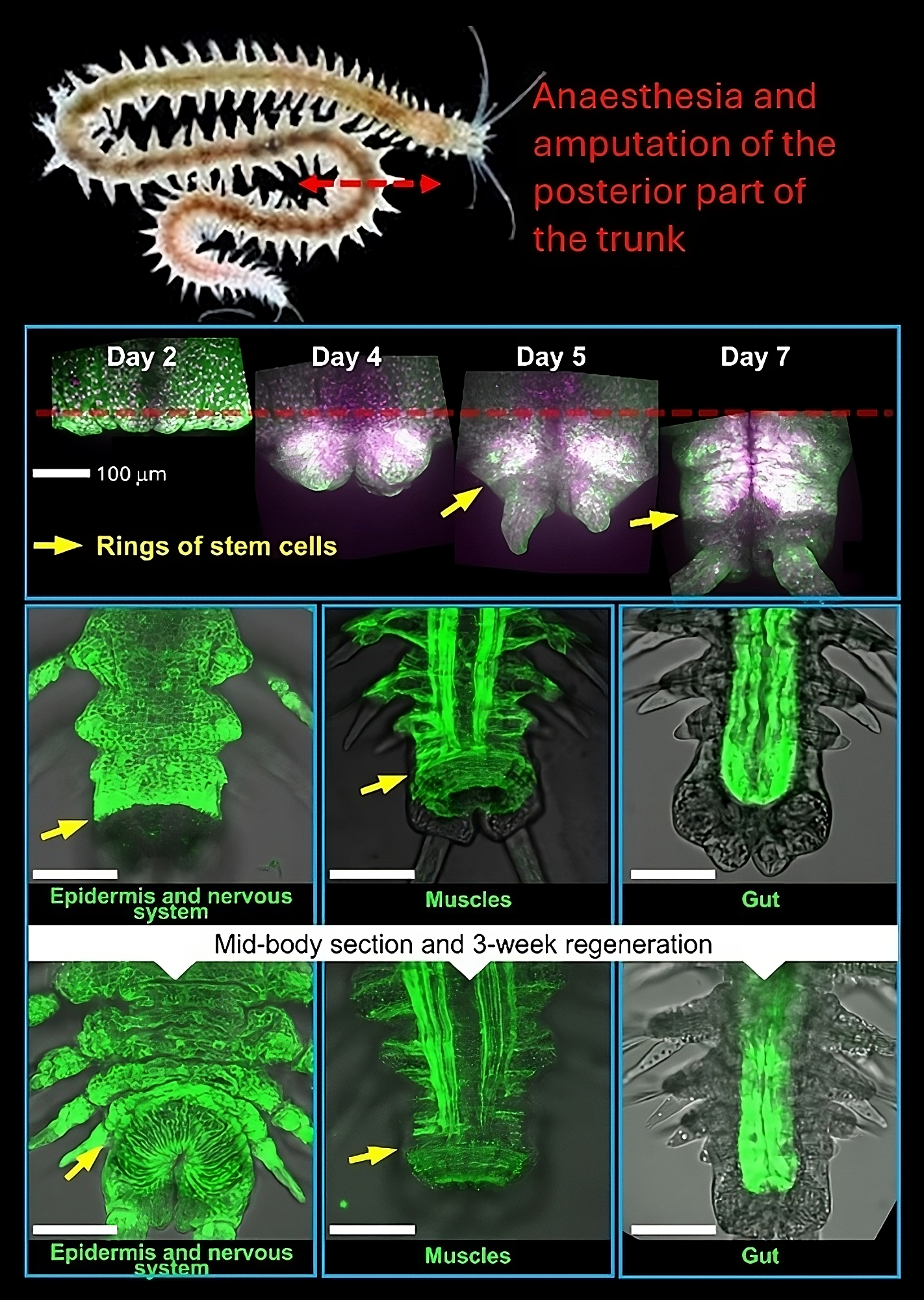Follow us on Google News (click on ☆)
These findings differ greatly from those observed in other worms and thus provide the scientific community with new perspectives for understanding the mechanisms of regeneration.

Confocal microscopy tracking of the regeneration of worms carrying clonal lineages of fluorescent transgenic cells.
- 1st row: photograph of a worm showing the approximate positions of the amputations performed.
- 2nd row: tracking of four stages of regeneration in a worm where all epidermal cells are clonal and fluorescent; the blastema grows and begins to take shape between days 1 and 4. From day 5, the regenerated posterior stem cells become active again and produce new worm segments.
- 3rd row: posterior parts of three worms carrying fluorescent clones in three different tissues, before amputation.
- 4th row: regeneration results for the same three worms after three weeks; the regenerated fluorescent tissues are exactly the same as before amputation.
© Creative Commons
In many animals, the regeneration of a limb or a damaged structure relies on the formation of a blastema, a mass of specialized progenitor cells capable of reforming the various cells of complex tissues.
In a study published in Nature Communications, scientists used an animal model, a marine annelid worm, to explore the mechanisms of regeneration. They aimed to understand how this regenerative capacity is organized in time and space in an invertebrate, using a combined genetic and cellular approach.
Regeneration in the annelid worm shares similarities with that of certain vertebrates
The scientists combined genetic analysis techniques (transcriptomics—an inventory of the genes expressed in a given cell) and cell tracing methods (which allow tracking an individual cell's trajectory) to identify the cells involved and follow their development during regeneration.
They observed that in annelid worms, the cells forming the blastema after tail amputation exhibit similar characteristics to those previously studied in vertebrates with strong regenerative abilities, such as amphibians. These cells, in both annelid worms and salamanders or frogs, possess what is called a "restricted" capacity. Unlike pluripotent stem cells (capable of regenerating any cell type), these "restricted-potential" cells remain specialized according to their layer of origin (the three embryonic germ layers: ectoderm, mesoderm, endoderm).
This restriction implies that regeneration in this annelid worm is based on the "dedifferentiation" of specialized cells near the injury site, which revert to an undifferentiated state but do not change their specialization. They maintain a fixed "identity" that cannot be altered during the regeneration process.
Finally, the posterior growth of the worm, beyond any regeneration, itself relies on populations of stem cells with restricted destinies. These posterior stem cells, lost after amputation, are consequently regenerated from differentiated cells of the same identity, which they had previously produced during the growth process.
A new model for exploring the mechanisms of regeneration
From this perspective, the annelid worm is very different from another group of worms studied for its remarkable regenerative capacities: flatworms or planarians. Planarians possess pluripotent stem cells solely responsible for their growth and regeneration. Comparative studies of these animal models will provide significant insights in the future and allow a deeper understanding of the mechanisms at play in vertebrates.
The scientists highlight another important point: these restricted-potential cells in marine worms are activated by a molecular signaling pathway known as the TOR pathway, which is also involved in regeneration in vertebrates, such as the salamander. By inhibiting this pathway in the worm, regeneration is effectively halted, proving its central role in activating stem cells after injury.
This work contributes to advancing knowledge on the biology of regeneration, offering a methodological framework that can be applied to other species to compare the mechanisms involved.
Reference:
Molecular profiles, sources and lineage restrictions of stem cells in an annelid regeneration model.
A. Stockinger, L. Adelmann, M. Fahrenberger, C. Ruta, B. Duygu Özpolat, N. Milivojev, G. Balavoine, F. Raible.
Nature Communications, DOI: 10.1038/s41467-024-54041-3